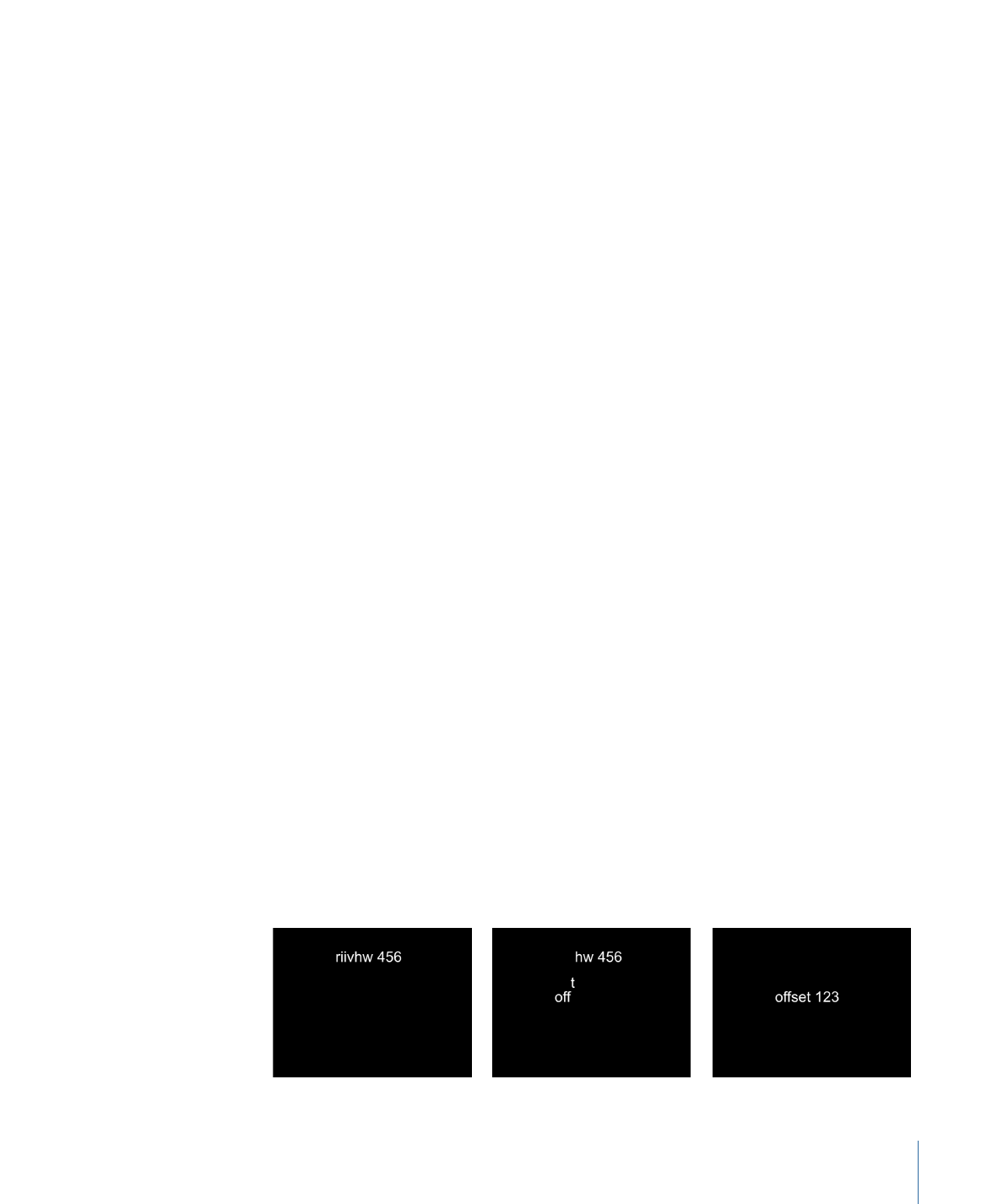
Sequence Text Controls
The Sequence Text behavior has the following parameter controls in the Behaviors
Inspector.
Parameter (Add and Remove):
Use the Add and Remove pop-up menus to add and
remove text format and style parameters to the sequence. After a parameter is chosen,
its controls appear above the Add and Remove pop-up menus. There are five Add pop-up
menu items—Format, Face, Outline, Glow, and Drop Shadow—each of which invokes
additional submenu items.
• Format: Choose any of eight Format parameters from the submenu: Position, Opacity,
Scale, Rotation, Tracking, Baseline, Slant, or Character Offset. Except for Character Offset,
these parameters are also found in the Format pane of the Text Inspector. (For more
information on text format parameters, see
Editing Text Format
.)
Choose the Character Offset option to offset characters alphabetically or numerically.
The amount of the offset is determined by the value set in the parameter. In the
following illustrations, Character Offset and Position are sequenced. The Character
Offset Value is 3. The words move in sequence from the character offset value to form
the original words, “offset 123.”
913
Chapter 17
Animating Text

When you choose Format > Character Offset from the Add pop-up menu, the Character
Set pop-up menu appears in the Behaviors Inspector. There are two menu options:
Preserve Case & Digits and Full Unicode. Choose Preserve Case & Digits to ensure that
offset characters respect the case and number of the original text. For example, with
this option selected, an uppercase letter remains uppercase as other letters cycle
through its position.
Note: Using the onscreen controls to manipulate the scale, position, or rotation of the
text unit adds Format parameters to the Sequence Text behavior. For more information
on using onscreen controls to sequence text, see
Using the Custom Sequencing Option
.
• Face: Choose any of four Face parameters for sequencing: Color, Opacity, Blur, or Four
Corner. For more information on text face parameters, see
Text Face Controls in the
Style Pane
.
• Outline: Choose any of six Outline parameters for sequencing: Color, Opacity, Blur,
Width, Layer Order, or Four Corner. For more information on text outline parameters,
see
Text Outline Controls in the Style Pane
.
• Glow: Choose any of eight Glow parameters for sequencing: Color, Opacity, Blur, Radius,
Scale, Offset, Layer Order, or Four Corner. For more information on text glow parameters,
see
Text Glow Controls in the Style Pane
.
• Drop Shadow: Choose any of seven Drop Shadow parameters for sequencing: Color,
Opacity, Blur, Scale, Distance, Angle, and Four Corner. For more information on text
drop shadow parameters, see
Text Drop Shadow Controls in the Style Pane
.
Sequencing:
This pop-up menu sets how the sequence animation moves through the
text unit. (A text unit can be a character, word, line, or an entire text object, as set in the
Unit Size pop-up menu, described below.) There are five items in the Sequencing pop-up
menu:
• To: Specifies that the animation begins at the original parameter value and moves to
the value set in the sequence behavior. For example, if the original opacity value is
100% and opacity is set to 0% in the Sequence Text parameters, the text unit begins
completely opaque and becomes completely transparent.
• From: Specifies that the animation moves from the value set in the sequence behavior
to the original parameter value. For example, if the original opacity value is 100% and
opacity is set to 0% in the Sequence Text parameters, the text unit begins completely
transparent and becomes completely opaque. This is the opposite of the To option in
the Sequencing pop-up menu.
• Through: Specifies that the sequence goes through a full animation cycle starting at
the original value of the parameter, moves to the value set in the sequence behavior,
and then returns to the original value of the parameter. For example, if the original
opacity value is 100%, and opacity is set to 0% in the Sequence Text parameters, the
text unit begins completely opaque, becomes transparent, and then becomes
completely opaque again.
914
Chapter 17
Animating Text

• Through Inverted: Specifies that the sequence goes through an inverted animation
cycle starting from the value set in the sequence behavior, moves to the original value,
and then returns to the value set in the sequence behavior. For example, if the original
opacity value is 100% and opacity is set to 0% in the Sequence Text parameters, the
text unit begins completely transparent, becomes opaque, and then becomes
completely transparent. This is the opposite of the Through Sequencing option.
• Custom: Allows you to keyframe how the animation moves through the values set in
the Sequence Text parameters. When Custom is selected from the Sequencing pop-up
menu, the Minimum and Maximum parameters in the Variance controls (see description
below) are replaced with the Amount parameter, and the Fix pop-up menu appears.
Unit Size:
This pop-up menu specifies whether the animation is sequenced by Character
(the default setting), Character (without spaces), Word, Line, All, or Custom (a keyframed
range).
• Character: Sequences the animation by single characters of text (including spaces).
• Character (without spaces): Like the Character setting, sequences single characters of
text, but does not treat spaces as characters (spaces are ignored).
• Word: Sequences the animation by word.
• Line: Sequences the animation by lines of text.
• All: Sequences the animation through the entire text object.
• Custom: Allows you to customize the size of the sequenced text unit. When Custom is
selected from the Unit Size pop-up menu, the Start and End parameters become
available. These parameters define the size of the selection.
Start:
This slider, available when Unit Size is set to Custom, defines the starting point of
the selection to be sequenced.
End:
This slider, available when Unit Size is set to Custom, defines the ending point of
the selection to be sequenced.
Spread:
This slider controls the amount of falloff at the beginning and end of the
sequencing. To create a softer transition between each text unit, increase the Spread
value.
Direction:
This pop-up menu sets the direction of the sequencing to Forwards (default),
Backwards, Center to Ends, Ends to Center, or Random.
• Forwards: Sequences in the direction of the letters (typically left to right).
• Backwards: Sequences in the reverse direction, (typically right to left).
• Center to Ends: Sequences from the center of the text outwards.
• Ends to Center: Sequences from the outer edges of the text inwards.
• Random: Randomizes the direction of the sequencing. When Random is selected from
the Direction pop-up menu, the Random Seed parameter becomes available.
915
Chapter 17
Animating Text

Random Seed:
This control, available when Direction is set to Random, allows you to
change the current “randomness” (seed number) of the direction of the sequence by
typing a new number or clicking the Generate button.
Speed:
This pop-up menu tat sets the action of the sequence behavior to Constant, Ease
In, Ease Out, Ease Both, Accelerate, Decelerate, or Custom.
Note: By default, the sequence animation lasts for the duration of the text object to which
it is applied. You can speed or slow the behavior by adjusting its bar in the mini-Timeline
or Timeline. For more information, see
Changing the Speed of Text Behaviors
.
• Constant: The sequence animation moves from one end of the text to the other at a
constant rate. The sequence moves in the direction specified in the Direction pop-up
menu.
• Ease In: The sequence animation begins slowly and increases to normal speed as it
moves through the text.
• Ease Out: The sequence animation begins at normal speed and slows toward the end
of the text.
• Ease Both: The sequence animation begins slowly, increases to normal speed as it
moves toward the middle of the duration of the text, and slows as it reaches the end
of the text.
• Accelerate: The rate of the sequence animation increases as it moves through the text.
• Decelerate: The rate of the sequence animation decreases as it moves though the text.
• Custom: Allows you to keyframe how the selection (the animation) moves through the
text. When Custom is selected from the Speed pop-up menu, the Custom Speed
parameter becomes available.
Custom Speed:
This slider, available when Speed is set to Custom, allows you to keyframe
the completion of the sequencing by defining the location of the text where the animation
is in effect.
Loops:
This slider sets the number of times the animation sequences through the text
over its duration.
Apply Speed:
This pop-up menu controls the speed of the sequencing over multiple
loops. There are three menu options:
• Once Per Loop: The setting chosen in the Speed pop-up menu is applied one time for
each loop. For example, if Speed is set to Accelerate, the rate of the sequence animation
increases as it moves through the text for every loop.
• Over Entire Duration: The setting chosen in the Speed pop-up menu is applied one time
for the length of the behavior. For example, if Speed is set to Accelerate, the rate of
the sequence animation increases as it moves through the text over the entire duration
of the behavior, regardless of the number of loops.
916
Chapter 17
Animating Text
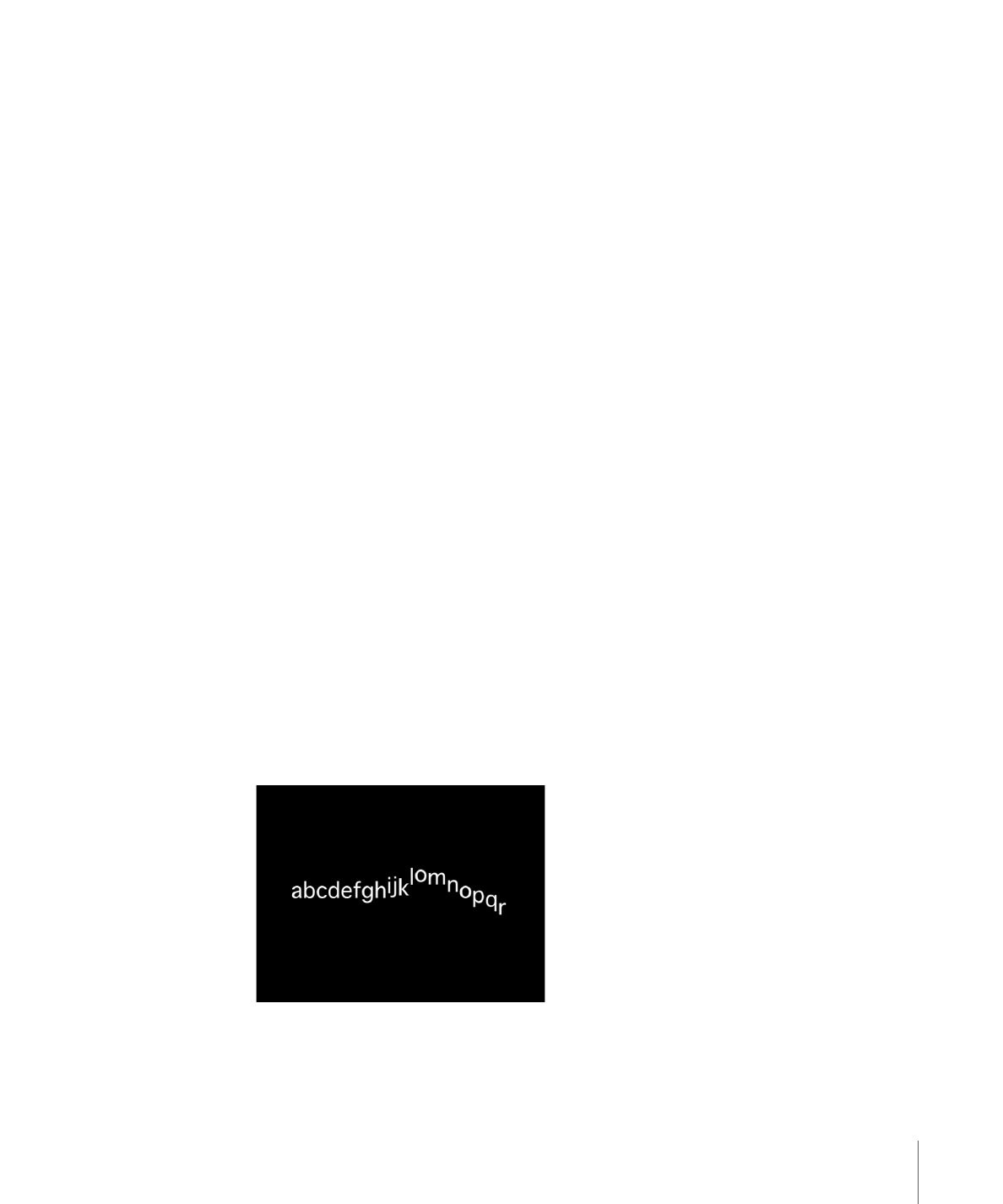
• Per Object: The setting chosen in the Speed pop-up menu is applied one time for each
object for every loop. For example, if Speed is set to Accelerate, the rate of the sequence
animation increases as it moves through each text object for every loop.
End Condition:
This pop-up menu specifies how the animation is applied to the end of
the sequence animation. There are three options:
• Hold: Completes the sequence animation cycle one time, then starts it over from the
beginning (after the last text unit in the sequence completes its animation).
• Wrap: Treats the sequence animation as a continuous loop so the spread wraps from
the last text unit in the sequence to the first text unit.
• Ping-Pong: Completes the sequence animation cycle forward, then completes the
animation backward, then forward, and so on.
End Offset:
A slider that offsets the end of the effect of the sequence behavior. By default,
the sequence animation is in effect until the end of the behavior. For example, to stop
the sequencing 60 frames from the end of the text object (or project), drag the End Offset
slider to 60 or enter 60 in the value field. Using this slider to stop the effect, rather than
trimming the end of the behavior in the Timeline, freezes the end of the effect for the
remaining duration of the object. Trimming the end of the behavior resets the text to its
original settings.
Variance:
This group of controls allows you to randomize the attributes assigned to
sequence through the text. For example, if you add variance to a scale sequence, the text
scale is randomized rather than moving from the original Scale value to the Scale value
defined in the sequence behavior. These sliders control the frequency of the randomness.
When sequencing is set to To, From, Through, or Through Inverted, it is useful to see how
the Variance numbers affect the randomness. The following image shows a sequence
animation in which the Y Position is offset. When a low variance value (frequency) is
applied, the randomness is very smooth along the line of text—like the text is riding a
very slow and smooth wave.
917
Chapter 17
Animating Text
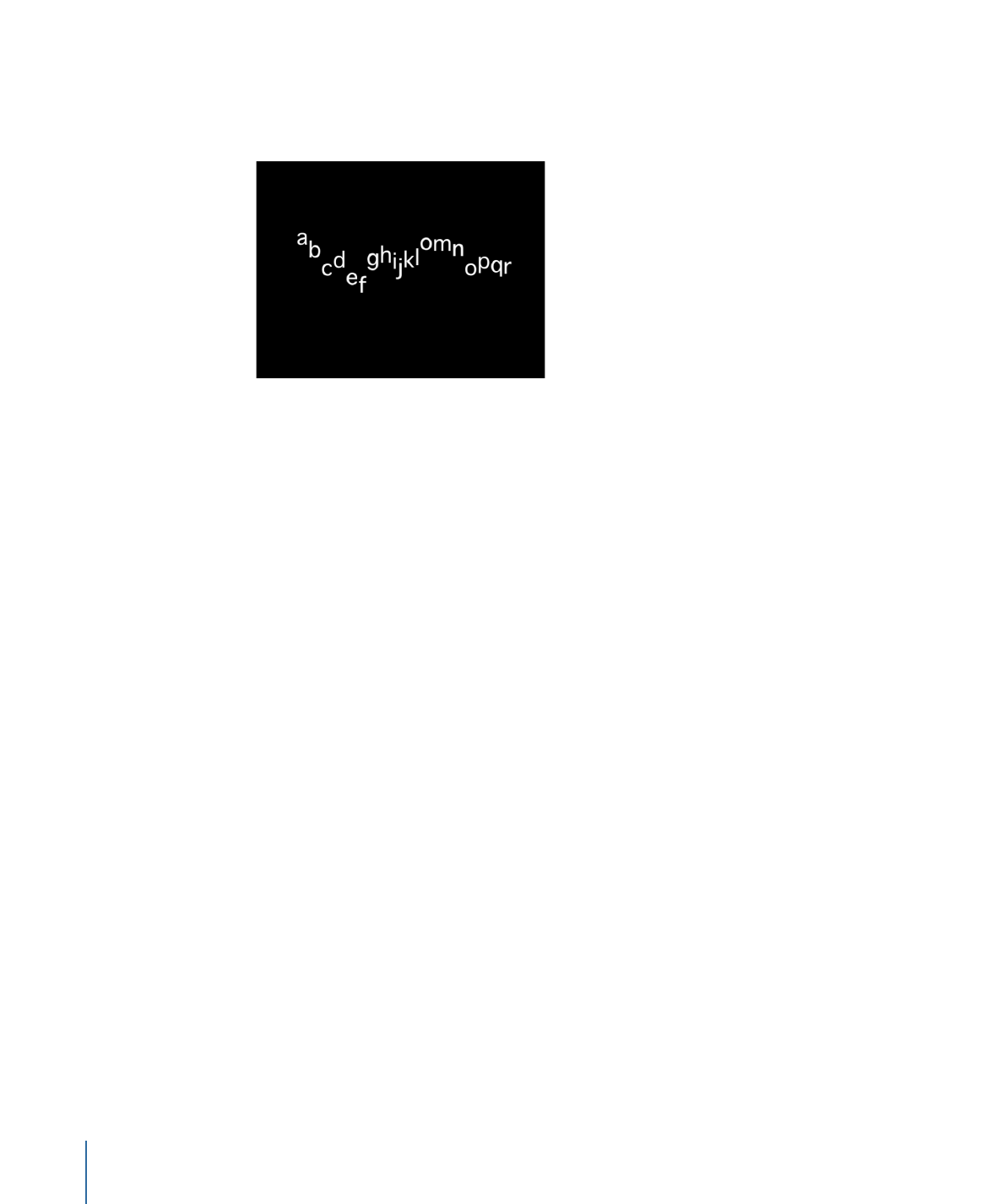
As the variance is increased, the randomness increases across the line of text. Because
the text is riding on very short and frequent waves, the letters are offset in the Y axis with
more randomness.
When Custom is chosen from the Sequencing pop-up menu, the same principle applies,
so a low variance value causes the text to offset from its animation with a smooth path,
while a high variance causes more randomness.
Note: Because the Variance parameters are sensitive, low values are necessary for smooth
animation results.
• Variance: A slider that allows you to fluctuate the values of the attributes assigned to
sequence through the text. For example, if you add variance to an opacity sequence,
the text opacity is randomized rather than moving strictly from the original Scale value
to the Scale value defined in the sequence behavior.
• Minimum: A slider that defines the lower boundary of the variance for the sequenced
parameter value. For example, if you set Minimum to 25% for a sequence animating
text scale, the minimum size that the text unit will scale to is 25% of the Scale value
set in the behavior.
Note: When Custom is selected from the Sequencing pop-up menu, the Minimum and
Maximum parameters are replaced with the Amount parameter.
• Maximum: A slider that defines the upper boundary of the variance for the sequenced
parameter value. For example, if you set Maximum to 75% for a sequence animating
text scale, the maximum size that the text unit scales to is 75% of the Scale value set
in the behavior.
Note: When Custom is chosen from the Sequencing pop-up menu, the Maximum and
Minimum sliders are replaced with the Amount slider.
918
Chapter 17
Animating Text
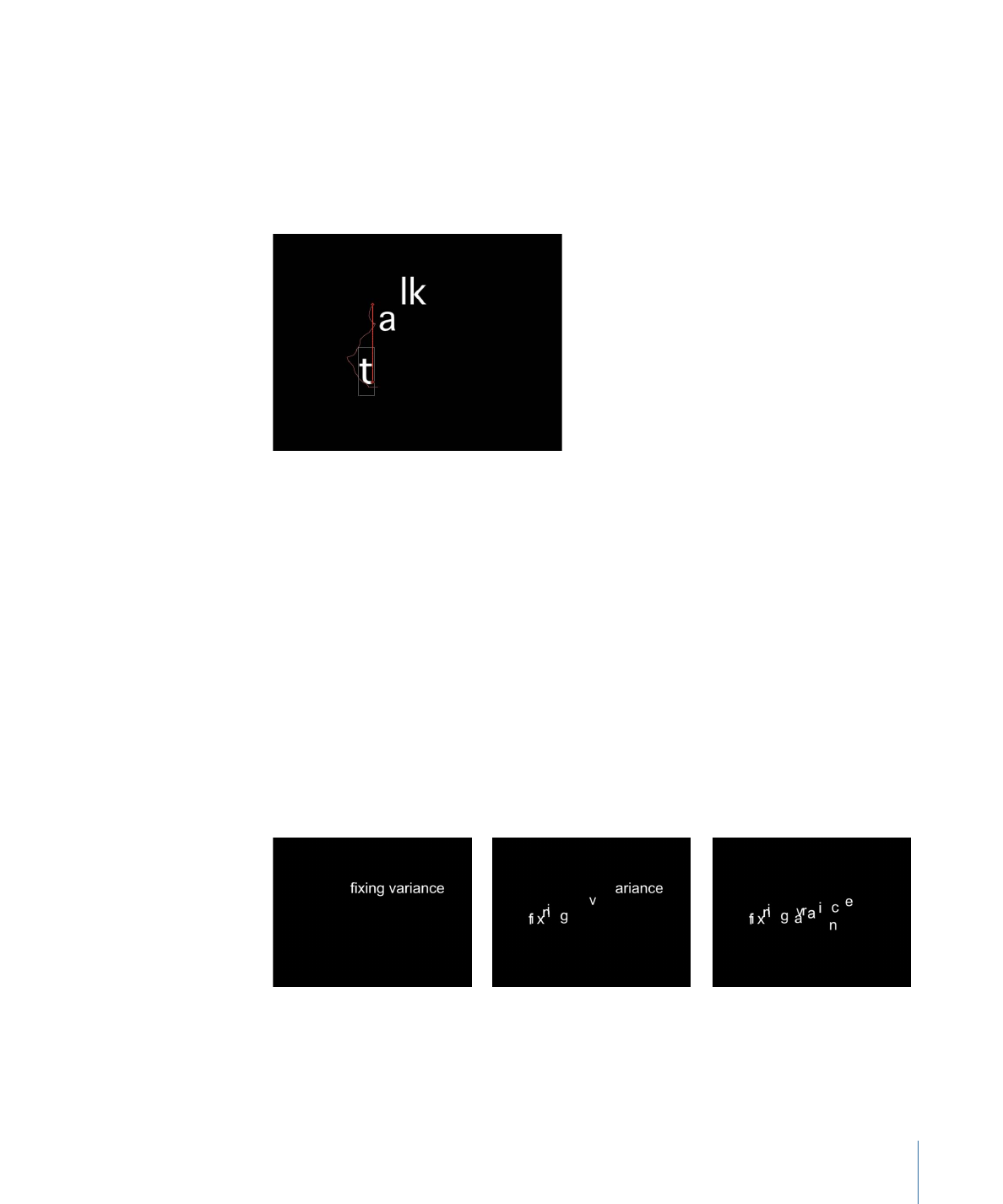
• Amount: A slider that becomes available when Custom is chosen from the Sequencing
pop-up menu, and defines the maximum amount that the animated parameter can
deviate from its animation value. For example, the following image shows a custom
animation of a glyph in the positive Y direction. When Amount is set to 50, the glyph
deviates no more than 50 pixels to the left or right of the animation path. The bold red
line shows the animation path, and the thinner red line displays the randomized path.
• Noisiness: A slider that adds an additional overlay of random variance. Higher Noisiness
values result in more erratic variations in the affected parameter.
• Seed: Click the Generate button to create an initial random seed for creating randomness
in the Variance parameters. To change the randomness results after you click Generate,
click the button again or enter a value in the field.
Fix:
Available when Sequencing is set to Custom, this pop-up menu fixes the values
defined in the behavior to the start, end, or start and end of the behavior. There is also
an option to not fix the values. Variance must be greater than 0 for this parameter to
have any effect.
• Start Point: When variance is applied, the values defined in the Sequence Text behavior
(above the Add and Remove pop-up menus in the Behaviors Inspector) at the start and
end of the behavior are fixed to the first frame of the behavior.
In the following images, the text position is sequenced. Fix is set to Start Point.
• End Point: When variance is applied, the values defined in the Sequence Text behavior
(above the Add and Remove pop-up menus) at the start and end of the behavior are
fixed to the last frame of the behavior.
919
Chapter 17
Animating Text
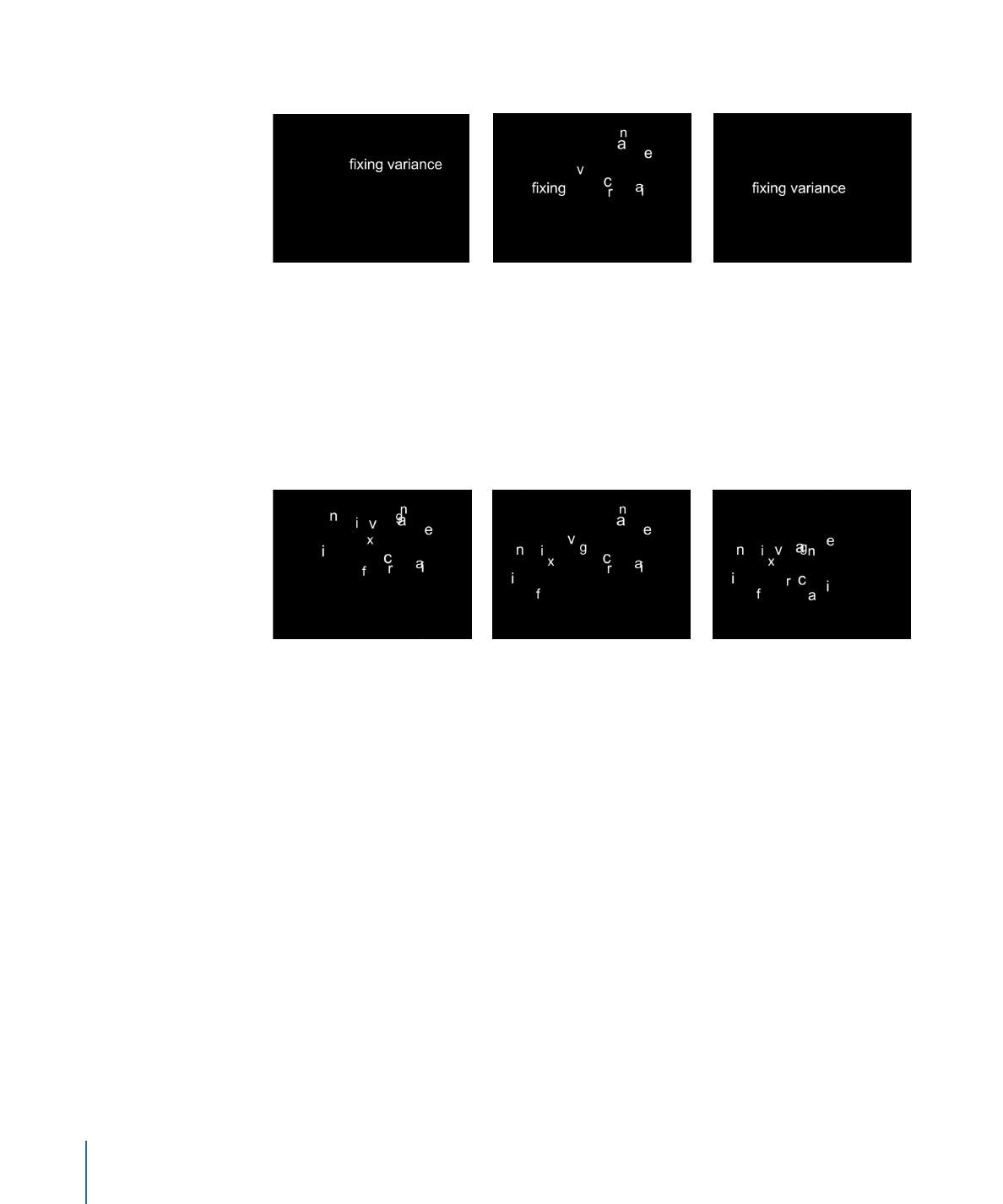
In the following images, the text position is sequenced. Fix is set to End Point.
• Both: When variance is applied, the values defined in the Sequence Text behavior
(above the Add and Remove pop-up menus) at the start and end of the behavior are
fixed to the first and last frames of the behavior.
• Neither: When variance is applied, the values defined in the Sequence Text behavior
(above the Add and Remove pop-up menus) at the start and end of the behavior are
not fixed to the first or last frames of the behavior.
In the following images, the text position is sequenced. Fix is set to Neither.
Attribute:
In addition to sequencing text attributes such as outlines, glows, and drop
shadows, you can sequence the warping of those attributes. Use the Attribute pop-up
menu to select the attribute you want to modify. There are five options:
• Transform Glyph: Displays the glyph onscreen controls, allowing for the selection of
characters of a text object for direct manipulation.
For more information about sequencing using the glyph onscreen tools, see
Using the
Custom Sequencing Option
.
• Face: Displays onscreen controls that allow you to modify the shape, size, and position
of the face (color fill) of text characters.
• Outline: Displays onscreen controls that allow you to modify the shape, size, and position
of the outline of text characters.
• Glow: Displays onscreen controls that allow you to modify the shape, size, and position
of the glow of text characters.
• Drop Shadow: Displays onscreen controls that allow you to modify the shape, size, and
position of the drop shadow of text characters.
920
Chapter 17
Animating Text

For more information about sequencing the warping of text attributes, see
Sequencing
the Distortion of Style Attributes
.
Position Type:
When offsetting text attributes such as glows and outlines from text
objects that contain characters of different sizes, this pop-up menu specifies whether an
attribute is offset from the text uniformly (choose Absolute), or offset based on the size
of text characters (choose Relative).
• Absolute: When offsetting attributes, such as glows, shadows, and so on from text
objects, choose Absolute to create an even offset regardless of the size of the text
characters.
In the following image, the yellow glow is uniformly offset from the white text because
Absolute is chosen from the Position Type pop-up menu.
• Relative: When offsetting attributes, such as glows, shadows, and so on from text
objects, choose Relative to create an offset based on the size of the text characters.
In the following image, the yellow glow is offset from the white text based on the size
of the text characters because Relative is chosen from the Position Type pop-up menu.
921
Chapter 17
Animating Text